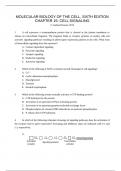Exam (elaborations)
molecular biology of the cell testbank of chapter 15 cell signaling and answers
- Course
- Institution
- Book
sixth edition the book molecular biology of the cel writer by Bruce Albert testbank of the book chapter 15 and answers
[Show more]




